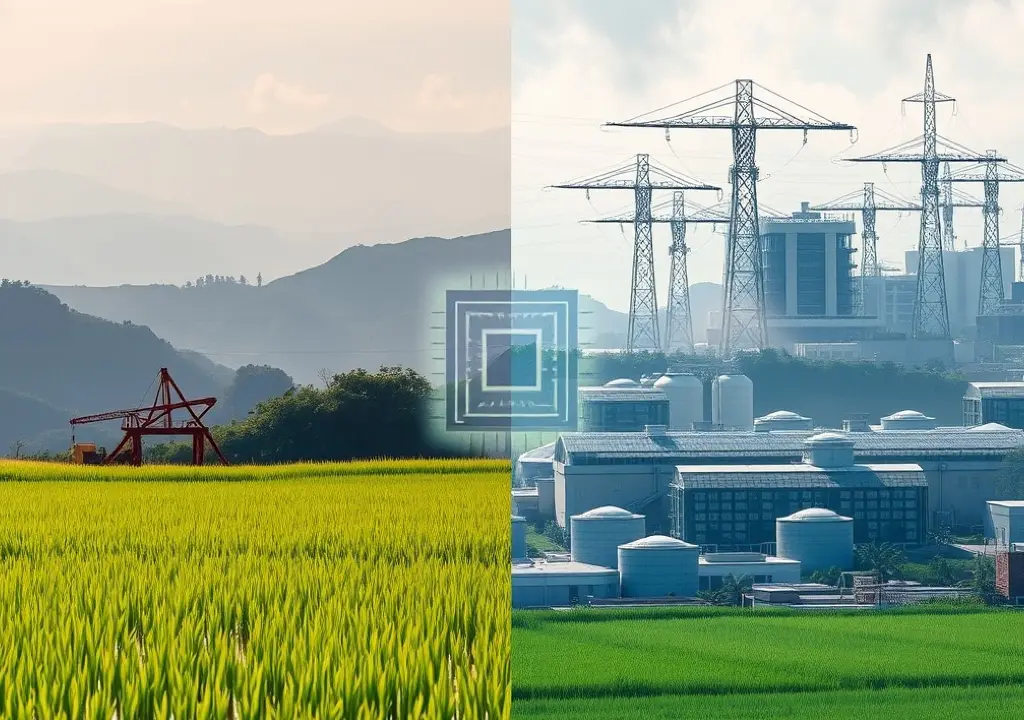The island’s semiconductor sector makes up a quarter of its GDP but is a leading source of carbon pollution.
Hsinchu, Taiwan – A crane glides above a calm rice field, water trickling softly. It’s a peaceful, almost cliché image of East-Asian rural life. Nothing suggests that just nearby lies a core engine of the world’s economy.
This is Hsinchu, near Taipei – Taiwan’s own version of Silicon Valley.
Beyond the paddies, massive buildings loom, their air conditioners humming amid city traffic. These factories manufacture the silicon chips powering phones, computers, and AI tools like ChatGPT.
But these two worlds – nature and advanced tech – are increasingly colliding.
Taiwan leads globally in chip production.
Taiwan Semiconductor Manufacturing Company (TSMC) is its top producer. By Q3 2024, TSMC held 64% of the global chip market, according to Counterpoint Research.
Samsung Foundry of South Korea followed far behind at 12%.
Chips dominate Taiwan’s economy, accounting for 25% of its GDP. In 2020, TSMC’s market value equaled nearly half of Taiwan’s economy, a report found.
While Taiwan dominates chipmaking, the industry brings environmental costs.
Chip plants use huge amounts of power and water, and emit harmful chemicals. TSMC alone uses 8% of Taiwan’s electricity, per S&P Global Ratings.
“After petrochemicals, electronics is Taiwan’s top polluter,” said Chia-Wei Chao of the Taiwan Climate Action Network and NTU.
“Semiconductors are growing rapidly, which is very concerning.”
This has sparked tensions with nearby farmers.
In 2021, a drought led the government to halt farm irrigation to supply chip plants. Now, concern grows that solar farms needed to power factories will consume farmland.
“There’s not enough environmental analysis of chip production,” Josh Lepawsky, geography professor at Memorial University in Canada, told Al Jazeera.
“That’s a serious oversight.”
AI Boom and Energy Strains
Although chip factories’ water use drew global attention recently, it’s no longer the main worry in Taiwan. Most factories now recycle water, and the government improved infrastructure after past droughts.
Now, the focus is energy use.
Breakthroughs in AI, driven by U.S. firms like OpenAI and its ChatGPT, rely on chips mostly made in Taiwan.
This AI surge is pushing Taiwan’s chip plants to work harder than ever.
“The AI market is more insane than ever,” said Lena Chang from Greenpeace East Asia.
“This drives up energy demand and emissions and could even cause shortages.”
Climate goals are losing attention in the race for AI.
“Everyone is focused on AI and its supply chains,” Chang noted.
“No one’s prioritizing energy. The government must push for sustainable energy.”
Slow Pace of Renewable Energy
Taiwan’s energy market poses challenges. It’s phasing out nuclear energy, but green energy growth is too slow.
“Taiwan still depends heavily on fossil fuels,” Chang said. “Over 80% of our energy comes from gas and coal.”
From Sept 2023 to Aug 2024, only 11% of Taiwan’s energy came from solar, wind, and hydro, per the Energy Administration.
Nuclear provided just 5.6% as it declines.
The government had aimed for 20% renewable energy by 2025, a goal it’s set to miss.
Offshore wind power is falling short. Taiwan approved 5.7 gigawatts (GW) for development by 2025.
But by 2024, it had lowered its goal, hoping for just 2.56–3.04 GW.
“Offshore wind grew steadily till 2022. After that, Taiwan wanted both cheap power and local manufacturing,” said Raoul Kubitschek of NIRAS Taiwan.
Yet domestic production isn’t scaling fast enough.
“You can’t build a supply chain overnight,” Kubitschek said. “Taiwan’s first big offshore wind farm came in 2017. Growing an industry takes time.”
Solar power faces limits, too. Rooftop solar is nearing saturation.
Larger solar farms meet opposition over land use. Farmers fear they’ll lose agricultural land, prompting protests and lawsuits.

